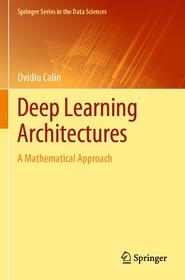
Deep Learning Architectures
A Mathematical Approach
Sorozatcím: Springer Series in the Data Sciences;
-
20% KEDVEZMÉNY?
- A kedvezmény csak az 'Értesítés a kedvenc témákról' hírlevelünk címzettjeinek rendeléseire érvényes.
- Kiadói listaár EUR 69.54
-
28 841 Ft (27 468 Ft + 5% áfa)
Az ár azért becsült, mert a rendelés pillanatában nem lehet pontosan tudni, hogy a beérkezéskor milyen lesz a forint árfolyama az adott termék eredeti devizájához képest. Ha a forint romlana, kissé többet, ha javulna, kissé kevesebbet kell majd fizetnie.
- Kedvezmény(ek) 20% (cc. 5 768 Ft off)
- Kedvezményes ár 23 073 Ft (21 974 Ft + 5% áfa)
Iratkozzon fel most és részesüljön kedvezőbb árainkból!
Feliratkozom
28 841 Ft

Beszerezhetőség
Megrendelésre a kiadó utánnyomja a könyvet. Rendelhető, de a szokásosnál kicsit lassabban érkezik meg.
Why don't you give exact delivery time?
A beszerzés időigényét az eddigi tapasztalatokra alapozva adjuk meg. Azért becsült, mert a terméket külföldről hozzuk be, így a kiadó kiszolgálásának pillanatnyi gyorsaságától is függ. A megadottnál gyorsabb és lassabb szállítás is elképzelhető, de mindent megteszünk, hogy Ön a lehető leghamarabb jusson hozzá a termékhez.
A termék adatai:
- Kiadás sorszáma 1st ed. 2020
- Kiadó Springer International Publishing
- Megjelenés dátuma 2021. február 14.
- Kötetek száma 1 pieces, Book
- ISBN 9783030367237
- Kötéstípus Puhakötés
- Lásd még 9783030367206
- Terjedelem760 oldal
- Méret 254x178 mm
- Súly 1480 g
- Nyelv angol
- Illusztrációk XXX, 760 p. 207 illus., 35 illus. in color. Illustrations, black & white 587
Kategóriák
Hosszú leírás:
This book describes how neural networks operate from the mathematical point of view. As a result, neural networks can be interpreted both as function universal approximators and information processors. The book bridges the gap between ideas and concepts of neural networks, which are used nowadays at an intuitive level, and the precise modern mathematical language, presenting the best practices of the former and enjoying the robustness and elegance of the latter.
This book can be used in a graduate course in deep learning, with the first few parts being accessible to senior undergraduates. In addition, the book will be of wide interest to machine learning researchers who are interested in a theoretical understanding of the subject.
Több
Tartalomjegyzék:
Introductory Problems.- Activation Functions.- Cost Functions.- Finding Minima Algorithms.- Abstract Neurons.- Neural Networks.- Approximation Theorems.- Learning with One-dimensional Inputs.- Universal Approximators.- Exact Learning.- Information Representation.- Information Capacity Assessment.- Output Manifolds.- Neuromanifolds.- Pooling.- Convolutional Networks.- Recurrent Neural Networks.- Classification.- Generative Models.- Stochastic Networks.- Hints and Solutions.
Több



